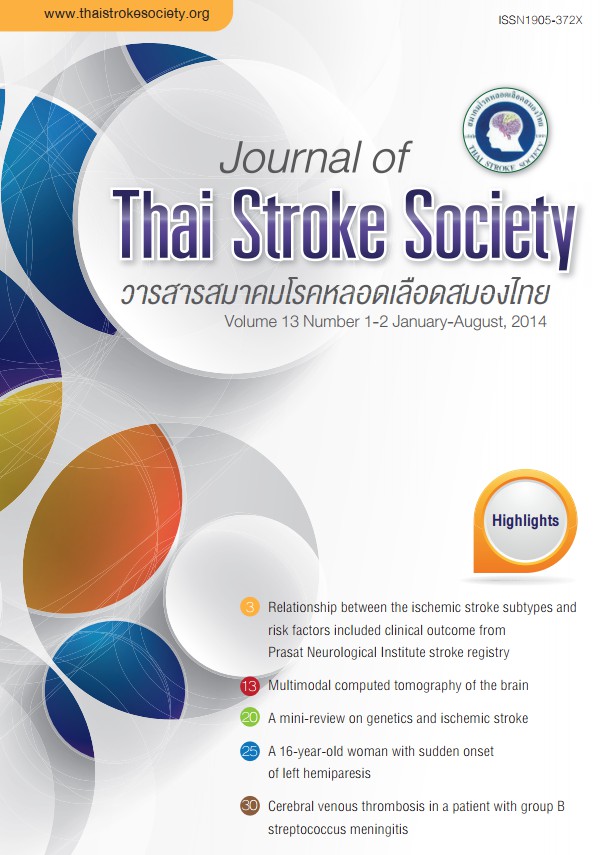Multimodal computed tomography of the brain
Keywords:
Multimodal computed tomography, perfusion computed tomography, computed tomography angiography, penumbra, acute ischemic strokeAbstract
Multimodal computed tomography comprised of noncontrast- enhanced computed tomography (NECT), perfusion computed tomography (CTP) and computed tomography angiography (CTA) has been increasingly used in research and clinical practice. CTP provides information about cerebral blood flow status. CTP parameters consist of cerebral blood volume (CBV), cerebral blood flow (CBF) and mean transit time (MTT). By gathering data from CTP parameters, penumbra and core infarct might be predicted. CTA provides information about vessel status, which may help in making decision about choices of treatment, such as intravenous thrombolysis or endovascular treatment, in patients with acute ischemic stroke
References
Am J Neuroradiol 1994;15:9-15.
Jauch EC, Saver JL, Adams HP, et al. Guidelines for the early management of patients with acute ischemic stroke: A guideline for healthcare professionals from the American Heart Association/ American Stroke Association. Stroke 2013;44:870-947.
Barber PA, Demchuk AM, Zhang J, et al. Validity and reliability of a quantitative computed tomography score in predicting outcome of hyperacute stroke before thrombolytic therapy: ASPECTS Study Group: Alberta Stroke Programme Early CT Score. Lancet 2000;355:1670-4.
Barber PA, Demchuk AM, Hudon ME, et al. Hyperdense sylvian fissure MCA ‘dot’ sing: a CT marker of acute ischemia. Stroke 2001;32:84-8.
The National Institute of Neurological Disorders and Stroke rt-PA Stroke Study Group. Tissue plasminogen activator of acute ischemic stroke. N Engl J Med 1995;333:1581-7.
Skutta B, Furst G, Eilers J, et al. Intracranial stenoocclusive disease: double-detector helical CT angiography versus digital subtraction angiography. AJNR Am J Neuroradiol 1999;20:791-9.
Hopyan JJ, Gladstone DJ, Mallia G, et al. Renal safety of the CT angiography and perfusion imaging in the emergency evaluation of acute stroke. AJNR
Am J Neuroradiol 2008;29:1826-30.
Biesbroek JM, Niesten JM, Dankbaar JW, et al. Diagnostic accuracy of CT perfusion imaging for detecting acute ischemic stroke: A systemic review and meta-analysis. Cerebrovasc Dis 2013;35:493-501.
Lui YW, Tang ER, Allmendinger AM, et al. Evaluation of CT perfusion in the setting of cerebral ischemia: patterns and pitfalls. AJNR Am J Neuroradiol 2010;31:1552-63.
Royter V, Paletz L, Waters MF. Stroke vs status epilepticus: a case report utilizing CT perfusion. J Neurol Sci 2008;266:174-6.
Lev MH, Segal AZ, Farkas J, et al. Utility of perfusion-weighted CT imaging in acute middle cerebral artery stroke treated with intra-arterial thrombolysis: prediction of final infarct volume and clinical outcome. Stroke 2001;32:2021-28.
Downloads
Published
How to Cite
Issue
Section
License
ข้อความภายในบทความที่ตีพิมพ์ในวารสารสมาคมโรคหลอดเลือดสมองไทยเล่มนี้ ตลอดจนความรับผิดชอบด้านเนื้อหาและการตรวจร่างบทความเป็นของผู้นิพนธ์ ไม่เกี่ยวข้องกับกองบรรณาธิการแต่อย่างใด การนำเนื้อหา ข้อความหรือข้อคิดเห็นของบทความไปเผยแพร่ ต้องได้รับอนุญาตจากกองบรรณาธิการอย่างเป็นลายลักษณ์อักษร ผลงานที่ได้รับการตีพิมพ์ในวารสารเล่มนี้ถือเป็นลิขสิทธิ์ของวารสาร





